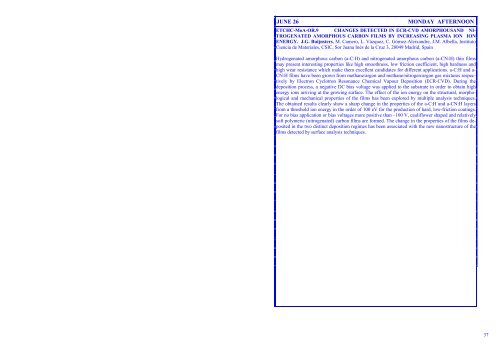Wüest M. 51 Wykes M. 82 Yamaguchi M. 17 Ybarra G. 129 Yubero F ...
Wüest M. 51 Wykes M. 82 Yamaguchi M. 17 Ybarra G. 129 Yubero F ...
Wüest M. 51 Wykes M. 82 Yamaguchi M. 17 Ybarra G. 129 Yubero F ...
Create successful ePaper yourself
Turn your PDF publications into a flip-book with our unique Google optimized e-Paper software.
JUNE 26 MONDAY AFTERNOON<br />
ETCHC-MoA-OR.9 CHANGES DETECTED IN ECR-CVD AMORPHOUSAND NI-<br />
TROGENATED AMORPHOUS CARBON FILMS BY INCREASING PLASMA ION ION<br />
ENERGY. J.G. Buijnsters, M. Camero, L. Vázquez, C. Gómez-Aleixandre, J.M. Albella, Instituto<br />
Ciencia de Materiales, CSIC, Sor Juana Inés de la Cruz 3, 28049 Madrid, Spain<br />
Hydrogenated amorphous carbon (a-C:H) and nitrogenated amorphous carbon (a-CN:H) thin films<br />
may present interesting properties like high smoothness, low friction coefficient, high hardness and<br />
high wear resistance which make them excellent candidates for different applications. a-C:H and a-<br />
CN:H films have been grown from methane/argon and methane/nitrogen/argon gas mixtures respectively<br />
by Electron Cyclotron Resonance Chemical Vapour Deposition (ECR-CVD). During the<br />
deposition process, a negative DC bias voltage was applied to the substrate in order to obtain high<br />
energy ions arriving at the growing surface. The effect of the ion energy on the structural, morphological<br />
and mechanical properties of the films has been explored by multiple analysis techniques.<br />
The obtained results clearly show a sharp change in the properties of the a-C:H and a-CN:H layers<br />
from a threshold ion energy in the order of 100 eV for the production of hard, low-friction coatings.<br />
For no bias application or bias voltages more positive than –100 V, cauliflower shaped and relatively<br />
soft polymeric (nitrogenated) carbon films are formed. The change in the properties of the films deposited<br />
in the two distinct deposition regimes has been associated with the new nanostructure of the<br />
films detected by surface analysis techniques.<br />
37
















